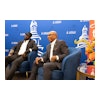Tech Program Trains Next Generation
Of Minority Entrepreneurs
For two weeks every summer at a small college in West Virginia’s northern panhandle, classes start at 8 a.m. and end at 5 p.m. But the work doesn’t stop there.
Broken into 10 teams, students in the seven-year-old Emerging Minority Business Leaders program continue working into the night, checking through patents of new technologies, arguing over best approaches, anticipating pratfalls and finally putting together competing business plans. One team wins.
“It was pretty intense, but it inspired me to start a business that was technology focused,” says SherRhonda Gibbs, who was on a winning team and completed the EMBL course in 2005. Gibbs, now finishing her doctorate in entrepreneurship at Jackson State University in Mississippi, has her own biomedical startup in Baltimore.
That’s music to the ears of Tyrone C. Taylor, the director for Washington relations for the West Virginia High Technology Consortium Foundation. The foundation, along with the U.S. Department of Commerce’s Minority Business Development Agency, runs the $600,000-a-year EMBL program. It is important work, he says, “because the truth is that diversity in high tech isn’t where states would like to see it.” The program draws about 50 highly qualified, mostly minority students each year from throughout the country.
EMBL, however, may be about to go through some changes. The usual summer program at West Liberty State College runs June 10-21. But to keep it going past then, the tech foundation may have to raise some extra funds independently, Taylor says.
One reason is that the Minority Business Development Agency is reassessing how it funds programs. The agency, Taylor says, evaluates the program on contracts they produce, while the EMBL’s goal is to launch new generations of entrepreneurs.
Bridget Gonzales, chief of the Office of Legislative, Education and Intergovernmental Affairs at the MBDA, says no funds are in jeopardy at the moment. Her group has been in discussion with Taylor about upgrading the program. “They want to foster the technology transfer aspect among minority businesses since that’s been the weakest part of the program,” she says. One goal is to make students aware of what technologies the federal government already has that they can develop. “Over the years, this program has been evolving,” she says.
It won’t be the first time EMBL has been asked to weather a period of change. Initially, the program involved two months of classroom work. Participants were then sent on long-term internships with government agencies such as NASA and Sandia National Labs. Some worked as interns at major corporations with big research and development budgets, including Proctor & Gamble.
“The idea was ‘How can I connect to Fortune 500 companies or mid-sized companies with results that could be determined in dollars for those companies?’” says Taylor.
In 2003, the program shifted its focus. Instead of feeding large research and development labs, the program turned its attention to budding entrepreneurs who had the energy and skill to use new technologies to start their own businesses.
Most of the candidates for the program come from historically Black colleges and universities. But the program also admits older participants with considerable business experience.
David Spence was one of the candidates selected for last summer’s session. Spence graduated in December from the University of Maryland with a double major in nuclear engineering and criminology. “It was a good crash course on intellectual property issues,” he says of EMBL. “It was intense with a lot of reading and studying. It’s really diverse, too, with people coming from all over. It’s certainly a graduate-level course pressed down into two weeks.”
Spence now works full-time on intellectual property issues at the National Institutes of Health in Bethesda, Md. He hopes to start attending Georgetown University Law Center as a part-time student this fall.
Gibbs came into EMBL with prior experience as an entrepreneur. She helped start a business in Minnesota that marketed Cajun and Creole spices and foodstuffs, along with other goods, from Louisiana.
“EMBL really took me into a different direction as far as being an entrepreneur,” she says. “It moved me into computers and technology.”She says her most memorable time at EMBL was her team’s effort to come up with a “Launch Plan” to create a prototype entrepreneurial company. “We went through patents trying to select one to choose for the company. We won the competition,” she says.
She won more than that. Taking her experience, including the patent that her team chose, Gibbs ended up launching a limited liability company called Inovatrics Technologies. Now, Gibbs and her partner are looking for grant money to create products that can identify embolisms in human bodies.
© Copyright 2005 by DiverseEducation.com



















